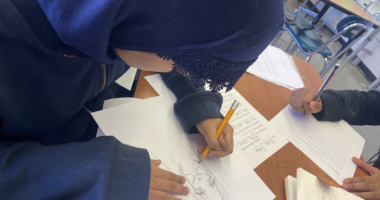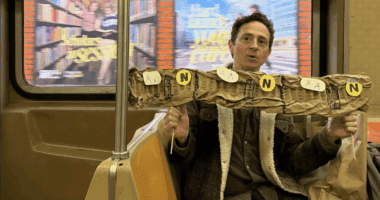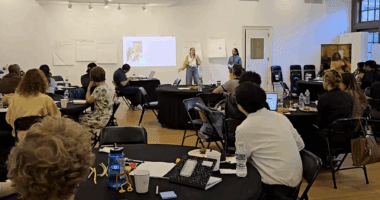Outside Voices is an interview series in which Community-Word Project catches up with community members.
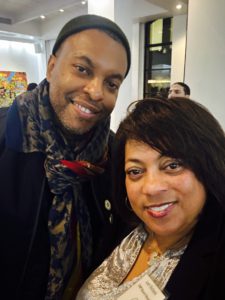
On this installment of Outside Voices, CWP Board Member Lori Bullock speaks with Sherwin Banfield, Artist and the recipient of CWP’s 2024 Artist of the Year award.
[Interview has been condensed and lightly edited for clarity.]
Lori Bullock: My name is Lori Bullock. As you know, I am a member of CWP’s Communications Committee and I am tasked often with interviewing subjects like yourself, sometimes there are teachers and educators. Sometimes they’re students, and sometimes they are teaching artists and on occasions such as today, they are prolific artists like yourself.
So we’re really honored to have you join us today.
Sherwin Banfield: Thank you, Lori.
Lori: I am an executive producer in advertising, so I work with artists and designers in my world and I know you are a visual artist that uses multiple disciplines and a different canvas that is both artistic and sonic and the hip hop world which is celebrating its 50th year. Can you believe that?
So first off, let’s just kind of talk about that. So I’m gonna open the door with you. Sort of honoring the whole genre of hip hop at 50 years, and how that affects your art.
Sherwin: Well, you know, anything to be heralded and supported and celebrated at 50 years, it’s quite an achievement. And this genre, this culture of hip hop has really done more than was anticipated from its inception. No one thought it would be this big.
No one thought that it would have this much effect on the world and being that it’s from New York…born, incubated, raised, and matured. It’s only right that the parties that helped to create this genre be celebrated in all shapes and forms, right?
I love this. I love the written word. You have a lot of articles. You have a lot of blogs and books and you name it that has created a means of looking back and has captured hip hop for quite some time.
Are we talking about, like, the Word Up! magazine?
Lori: Right On! magazine, yes.
Sherwin: Some folks took a while to accept hip hop. Right? Like a lot of the R&B, conservative, creative platforms took a while to accept hip hop, right?
It’s the voice of the people at the ground level and it came out of, you know, came out of the hood, came out of desolate environments. To see how it has matured and developed an incredible 50 years in and that has affected my work and my work is me, right.
I am creating my lived experience. I am trying to tap into the memories and the feelings and the moments that really helped to anchor some growth patterns for my own life. And when I start creating I have to talk about myself and what inspired me.
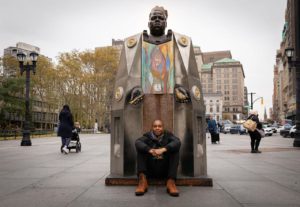
Many other things inspired me of course, you know, art is my greatest inspiration. Seeing the artist. Seeing the worlds of different cultures. The funny thing is when I traveled to other countries, whether its Japan, whether its the Caribbean, whether it’s in Europe… going to those cultural institutions, those cultural sites really has a profound effect on me and what I see in books.
Sculpture dating back to Africa and Egyptian Period and Benin Period. And I looked into the Renaissance, that stuff really took hold of me when I mixed those to my own story and what took hold of me, which is sculpture, figurative sculpture. Sculpting people’s faces, which is the most incredible thing to sculpt and the most difficult. It’s a challenge, but it’s also a great reward for me.
And to put that into focus with hip hop and add to the multitude of disciplines that have captured and have reported on hip hop and preserved it, I think sculpture was something that should be added to that.
And here I am making monuments and sculptures to those who have helped to create hip hop and also the environments, the neighborhoods that have nurtured these artists.
Lori: It’s pretty powerful. Obviously hip hop culture, which obviously embraces the art, the fashion, along with the music, along with the lexicon, the dialogue, the words and attributes that we use to describe things in the world of hip hop. Because it’s truly it’s own expansive an art form as you mentioned, borne out of the Bronx and it represents both the joy and the pain of what life is like in that shared inner-city experience. For youth that have struggled within that inner city be they African American, Afro Caribbean, Afro Latino, Hispanic and it’s a pretty powerful soundtrack.
I’d like to know what kind of influenced you the most as an artist early on. I know Biggie obviously has a huge impact in your work. It is noted with your kind of musical legacy and artistic legacy in Sky’s the Limit in the Country of Kings exhibit that you have.
But what ignites you to sort of create the work grounded in hip hop?

Sherwin: I think that. As I’m studying, you could take it back ten, fifteen years, as I’m studying sculpture in history and in practice. Uh, you know, there’s an academic approach to learning sculpture and that’s if you’re doing it on a representational scale of figurative sculpture, then there’s anatomy that you have to learn.
There is line-scale understanding of form and, yes, so much and different styles and different ways of looking at different subjects.
You have people coming in all sizes, shapes and forms, right? So there’s a practice. There’s a study. There’s an approach to understanding what artists have done to learn sculpture and what you’re doing.
There comes a point that, as you’re learning, at some point your voice has to penetrate and has to come out in the work that you do.
Lori: Sure.
Sherwin: You can go to the Metropolitan Museum of Art and see many folks copying paintings, copying drawings, and that’s an exercise to absorb those master artists’s approach, right? But there comes a point where your own voice has to be heard. And for me, it was looking into what inspired me. And hip hop was that thing.
And when I think about sculpture that exists in public parks throughout New York. It’s an experience to walk up to it, look at it, and have a tactile feeling of what it feels like to make it or what the material feels like if you touch it. But I want to add a component to mines which is the audio component since I decided to create my monumental sculpture that is representational of hip hop figures. Culture shifters.
Lori: Right.
Sherwin: I wanted their work to also be experienced when you experience a culture that sculpture itself, and that was, you know, the basis of foundations of most of the ideas. And it just the inspiration came just through doing it and completing it and seeing reactions.
It’s ah, what I mean by that is OK, so I’ve created the sculpture of a particular sculpture. A hip hop artist and in the end exhibiting it, being in this space and witnessing others experience it and some of them coming up and asking me, you know, what would I do next? Or you should try this person or that person…that has led to other ideas to create other hip hop artists.
Lori: So you’re in a constant state of thinking, ideating, and creating art even when you don’t even cast your sculpture yet and start really putting your hands on it, you’re always walking around with the ideas in your head as you experience people, music. So it’s a constant state of evolution.
Sherwin: I love that.
Lori: I would imagine, which is quite remarkable. Umm. Yeah. Exactly.
Sherwin: Yeah, there’s the you got 100% and I may add to that it, it really is in my head. If you talk to a musician it’s already composed, either the blueprint, the foundation of the sonnet or the song. And through the process of making it, it gets completed. It’s completed to an extent and then it goes through a further evolution when it comes into the physical realm.
Lori: That’s extraordinary. So ideas pop in your head? You might take them on in a musical form based upon hip hop music that you might hear or beat that you might have heard, or a lyric or bars that you might have heard.
And then begins your process of what you’re going to cast as a sculpture, which is really an interesting process. I’m always fascinated by how artists begin their process and what the end deliverable is.
Sherwin: Right, right. And as you’re saying that I’m reflecting on the Notorious B.I.G piece as you are talking about lyrics. On the rear of that monument statue, I have designed these illustrations per se, right, which is cut out of steel. So they’re basically designs based on the lyrics.
Lori: Right.
Sherwin: So I’m illustrating a line from one of his songs in a visual and then the process that I choose to create it was designed in Adobe Illustrator. We make the sketch design in Adobe Illustrator, send that file to a laser cut fabricator. Who then sends the pieces. And then I have to weld together to create the final sculpted – what appears to be sculpted – that’s really illustrative sculpted designs…from his famous lines. And I choose certain lines based on certain memorable moments of his career, like his first song Juicy. Let’s go, let’s go to Hypnotize. Which one is most populous?
Lori: Yes.
Sherwin: “Tims for my hooligans in Brooklyn,” that’s a memorable line. And I created a design based on that.
Another one from his Big Papa song, which is, “To all the ladies in the place with style and grace.” Right? That goes to illustration so that when someone approaches the monument, if you don’t know who the Notorious B.I.G. is, it may pique your curiosity to find out what these words are. What do they mean? But for those who really know, who love Biggie then they see those lyrics, and they are immediately transported to a time when that lyric was meaningful for them, as I was when I heard those lyrics myself, right, so that’s how the world can affect the viewer.
And you know what? The song might be playing when you encounter those lyrics anyway as a sonic.
Lori: Pretty powerful. And you know, speaking of your ideation experience, CWP has had the wonderful opportunity to kind of experience you in an element while you were working at your exhibit, Sky’s the Limit: Music is my Resistance, in Brooklyn at the Billie Holiday Theater. We were there to sort of have the artist talk with you and we had a few students that were there as well that you were kind of taking them through your process, which was really quite wonderful to see.
I was kind of experiencing it through zoom and we had several of our CWP members there, both staff and board members.
I’d love to sort of ask you a little bit of what the feeling is like and watching some of our young students who are interested in art and they had this really wide-eyed curiosity when you were actually showing them how you were creating some of your sculpture and casting things. Tell me what that was a little bit like.
Sherwin: Well, it’s an awesome feeling because you’re participating in the transferring of knowledge. You’re literally adding water to a sponge, you know, and water is one of the greatest nutrients that you can have, you know, for growth. So it’s that knowledge pouring in, knowledge and experience, into a young person’s mind that hopefully can lead to a greater gift to the world. Like, they can offer something greater than what you were able to achieve, right?
There’s nothing like getting a response from a young, curious mind and seeing their eyes accept and understand what I am delivering to them and my process, right? It’s cool.
Lori: That’s very cool. I think you mentioned earlier rap music, the medium, and culture of hip hop, no one could have imagined what we started off with to where we are today.
Umm, you know, I grew up in Teaneck, NJ, which is the backyard of the Sugar Hill Gang and Sugar Hill Records. And funny enough, you know, both Biggie and Lil’ Kim lived in Teaneck as well, a little bit after they made it, but in terms of the cultural expression, there is sort of a purity in the goal of increasing representation and diversity in the space.
Obviously it’s an art form born out of the streets. It celebrates the contributions of people of color, and you were talking about recognizing the culture shifters that were creating it and the neighborhoods that raise and nurture the talent.
Why do you think that’s so important in grounding the educational root of hip hop for the masses around the world that don’t really understand the evolution of it or how it was born? So that BIPOC communities continue to benefit off of the mission of hip hop culture.
Sherwin: Well, that there’s a multilayer effect to preserving a culture like hip hop in the space that is rooted in if the decision makers of that space, say hip hop right of the Bronx, say Queens. You can say Brooklyn, let’s just let’s just go with the Bronx for this. This is the root of it.
If the decision makers that are in charge of the space of the blogs, and if they’re not, or if they fail to recognize how important hip hop is to the world and how preserving it for the world to understand and see its origins – if they fail to properly showcase it in a preserved, representational, true-to-story manner, then it will just become another story that gets hidden, that gets misinterpreted down the road for hijackers to hijack the story of it.
You can go all around the world and see the results of decision makers of spaces. That this particular person is of this space that has influenced the world, right, and, for example, which had a profound effect on me when I travel.
I tell the story all the time when I traveled to Austria, Salzburg, 2013; it was for a wedding. After the wedding, we are walking around Salzburg and I’m thinking, “Oh we gonna see sights with the Sound of Music. So cool, right?” I’m thinking of the the movie Sound of Music, but when we started walking around, I’m seeing everything Mozart which is informing me the folks who make the decisions for this space has decided to prop up Mozart in a permanence so that visitors who love Mozart or who may not know who Mozart is, I doubt anyone does. The academic systems around the world will come to see the hometown of Mozart And will experience what had created this particular genius.
So if we’re in New York, where hip hop is going out of and there isn’t any cultural institutions or anything that symbolizes hip hop is from here, that is permanent mural is not permanent right then it just becomes to me sends a message that the decision makers of this space has not considered this particular, umm, culture or people that important to create it into a permanence for the world to experience.
Lori: It’s pretty profound, pretty remarkable. I can really appreciate the manner of how you talk about creating space and who owns that space and who makes the decisions of what art, what culture is gonna be most significantly represented in that space?
So I think that has a profound impact on how we view the world through hip hop and how our students actually see themselves in and of the world, which is one of the tenants and the missions of CWP, where we want to sort of arm and advocate for our students by empowering them, you know, by teaching them the written word, the spoken word. And for those that are nonverbal, sometimes it’s with music.
They’re mural painting, and they’re fusing all of these elements together so that they can express themselves and find their voice and represent their culture, you know, and at times, their family and the communities that they are from, which are all really specific points of what hip hop also captures.
Obviously, we’ve got students that are represented from, you know, New York City, Manhattan, and also the five boroughs, much like you’ve got hip hop artists, you know, from the five boroughs, we’ve got Wu Tang from Staten Island. Biggie from Brooklyn.
We’ve got Doug E. Fresh from Harlem. We’ve got Kool Herc, you know, and team from the Bronx. And of course, we’ve got, Nas from Queensbridge.
So all of these specific neighborhoods contribute to the talent, the Community and hip hop representing the BIPOC community as well, and hopefully art that you create as well kind of continues to expand on that idea.
You also mentioned that hip hop is not only a unique style of spoken word, but you know through drum beats and samples, it’s really sort of another side of American history that I wasn’t taught. Maybe you weren’t taught, but now today it’s become so powerful that you cannot turn on the TV without seeing everything from Pampers to clothing to cleaning products around the house using some sort of hip hop beat or track to, you know, sell commerce, products.
How do you think that affects the world around that children are growing up in and what that means to how they see the world and what their, you know, what their limitations are? Are there limitations to what they can create?
Sherwin: I think it affects children in a way that is subconscious and can be misguided if the messaging given to the kid, to the children, to the youth is distorted and negative. Then it could lead to accepting it as a negative and seeing that culture as a norm as negative. But as a kid growing up, you don’t really see negative/positive, you accept it as it is.
If the message is negative, then your acceptance of your reality, it’s normal, but it’s perceived as negative from, you know, through the rest of the world that has a greater point of view.
It’s all around you, so you subconsciously, you know, take it in. If you are given a positive messaging to interpret this thing that is all around you, then that positive messaging affects you in a positive way and it becomes your norm.
You walking around with a norm that is positive, this is what the statue is about.
If I can choose many lyrics, many different lyrics of Biggie, many spicy lyrics to highlight on the statue, but I do not choose messaging that is considered negative. I choose messaging considered neutral or positive.
So when you’re at the sculpture, you’re seeing it in a positive light and at the end of the day, uh, Notorious B.I.G. is a stage name, right? That’s not his name and it’s up to him what he chooses to go by, but from my perspective, Notorious B.I.G. is a character that has stories to tell. Stories of drama. Confrontation of street culture, of club culture, and as the particular person, as he develops and matures, the messaging would likely change to that or start to involve some of that messaging, right?
What the youth experience is what they interpret and how they interpret it, and it’s up to the adults in the room to take hold of that…
Take Picasso, Picasso did some things that were considered not so, you know, positive. That’s what we do. So everyone, not everyone, but most people who we tend to cherish and nurture or hold to a high, you know, ideal as a human being more than likely have done something that’s you know it’s not positive…you know, that’s frowned upon.
I think that’s my interpretation of it, the message.
Lori: But it’s a great one. I mean, there’s certainly a lot of positive energy that resonates with your work. You know, the colors. The vibrancy, the shapes, the sizes of it you know, and then you added the Sonic component, you know, that are all representative from the boom box to the sculpture of Biggie umm, I think the students kind of resonated that night that you did the artist talk with them.
They were really just electrified by seeing everything and we had an opportunity to honor you and your work earlier last month, which was, which was quite a blast. I know the students were really excited to hear from you and your kind words of wisdom with respect to the art that you create. So that was also a joy for us.
Representing art today is really an evolution and a maturity that you grow with it, the more you do, the more you continue to work at it.
What advice would you give to some of our students that are interested in creating a legacy of work over time as budding artists, and we can continue to supply them with art education?
What simple rules would you give them to keep doing their work and trying to get better at it as an artist?
Sherwin: It’s a good question, I would say dedicate a portion of your life. Decide what percentage to give to the practice of that creative output and to never stop doing it. That’s really the key. If you are pausing for a moment, you’re pausing for a moment. If you stop, you’ll never know what kind of impact it could have on yourself and the world. That’s it.
Lori: That’s really important. I would say, that’s great advice as well.
Sherwin: Yeah, and it’s a ton of interactions and it’s up to you and sometimes you need someone to tell you – echoing what I said earlier – absorb what’s around you, but if you don’t have the messaging to interpret it in the correct or in the positive light, then you you might just go with the flow and accept it as what it is, or have a misinterpretation of it.
If, you know, if you love video games, just know that it’s considered a distraction from what your purpose is, right? It’s designed to pull you in and keep you. And that’s playing it, right, if you’re consuming it.
But what you have to offer is usually something that’s outputting from who you are inside of you, and it’s hard, it’s challenging to find and give what your talent is. If you are constantly consuming something that is designed to keep you, which I consider a distraction. So if you’re committing a certain amount of time to your creative practice, then you’re doing it and you’re making it. You’re taking something inside and you’re making it and putting it out.
And if you constantly do it, then it’s constantly evolving and you’ll be surprised what you have inside of you.
Lori: It’s great words of advice.
My last question for you really revolves around the constant state of hip hop growing, maturing, the artistic contribution that it is creating. And we’re starting to see really great success with artists who have graduated and become prolific actors, designers. They’ve influenced the fashion world like Kanye and with the rapper from Virginia, who works for Louis Vuitton, Pharrell Williams.
They seem to have so much to offer and to teach. They’re multi-disciplined in terms of how they market themselves. They’re proficient in music and business, and you know they’ve ventured into food, luxury items all the way down to their own bespoke wine.
It seems to be that there’s sort of a juggernaut of business opportunity. Do you think at some point it would be worthy, you know, if there are some sort of educational aspect that’s beneficial in teaching kids and teaching children the, not only the artistic value of hip hop, but how it’s made such an enormous creative impact from a business standpoint as well as an artistic standpoint. I mean, I know we’ve got Lupe Fiasco teaching a college course.
You know, there’s even courses now in college where they’re teaching the business of both Beyoncé and Taylor Swift. So I would say there might be some sort of offering where, you know, hip hop could be included in a curriculum somehow. At least the very nature from an artistic aspect.
I’d love to know your opinion about that.
Sherwin: I’ll go back to what I said earlier about interpreting it, right.
You can be a new listener of hip hop, and from a different culture and the parents say don’t listen to that music is degenerative music. It’s only played in the clubs. A lot of shootings. Or you can say wow, you listen to hip hop, do you know the amount of businesses and jobs that hip hop has created since its inception?
Do you even know how many brands work on hip hop or how many brands incorporate hip hop into their selling points, like you said earlier, for commerce. Do you even know the influence that jazz and rock’n’roll has had on hip hop and how hip hop has had influence on other cultures?
I mean, these are all positive, beautiful, enlightening interpretations of this music and culture. If it’s in the curriculum, you can teach that is what’s possible for hip hop. You could draw the complete line into different disciplines throughout the arts, throughout business, throughout science, throughout just about most things, right? And from there they can take that into something else. You know, the student can take that into something else and create something more.
I know an artist when I was part of an artist residency. There was a group of us, and once this particular artist from Sweden found out I was sculpting LL Cool J, he was floored. Completely floored, because growing up in Sweden, hip hop and LL Cool J had such an effect on him, he wanted to buy a candle hat, which was worn by grandmas.
Lori: Yeah. Amazing.
Sherwin: His mother told him, “Why would you want that hat? Only grandma’s wear that hat.” And he said, “Well, I love this hip hop.” Now he’s doing murals based on the graffiti of hip hop that really influenced him.
He’s doing murals in Sweden. He’s doing murals here in New York in New Jersey, throughout the country.
Lori: Incredible.
Sherwin: He’s taking how hip hop influenced him and using his own personal experiences to develop something from inside of him to give the world.
Lori: Pretty amazing. It is truly a global phenomenon around the world. I mean, as we close, you know, I was at the Cannes Art Film Festival for advertising last June. And Kendrick Lamar actually won artist of the year in terms of the art that he’s created and of course he’s the only hip hop artist I know that’s won a Pulitzer as well, which is pretty magnificent.
That goes to tell you where we are in the world today in terms of the contributions of hip hop and how it is also expanding to where we see more correct Caucasian artists that are fusing into hip-hop.
And we are seeing it in various capacities around the world where you know it’s done in Arabic, it’s done in French, it’s done in German, it’s done in, you know, African dialects. So it’s an incredible art form that continues to evolve.
And lastly, in terms of evolving art, what can we look forward to you in terms of what you’re going to be creating next that our students could look forward to seeing?
Sherwin: So I’ve created work of artists from Queens, from Brooklyn. I’ve done a piece of an artist, of an idea of hip hop from the Bronx. And now I’m creating a piece for Harlem.
Lori: Very nice! Next, we’ll have to get you out to the Jersey side. You know from Queen Latifah to Naughty By Nature to Das EFX. Yeah.
Sherwin: I grew up in East Orange, grew up in Montclair, you know. I know Das EFX from Teaneck. A lot of history over there in Jersey as well.
Lori: It’s really been a pleasure. I wanna make sure I don’t take up too much of your day. But we are so appreciative of your time in doing this interview. Also, your artist walk of your work at the Billie Holiday Museum, along with you speaking to everyone at CWP’s Annual Benefit earlier this spring. Hopefully, one of these days, we will look forward to you coming into the classroom and doing a workshop. We’ll stay in touch about that.
Sherwin: Of course, I would love to.
Lori: Well, thank you so much. Have a fantastic day and everybody from the CWP community thanks you and we’re most appreciative for this interview.
Sherwin: Awesome. I loved it. I appreciate it, Lori.
Lori: OK, take care. Have a great day.

